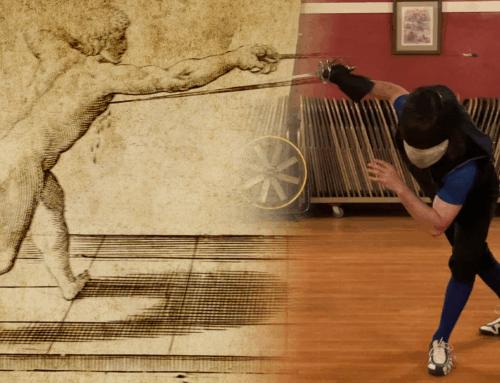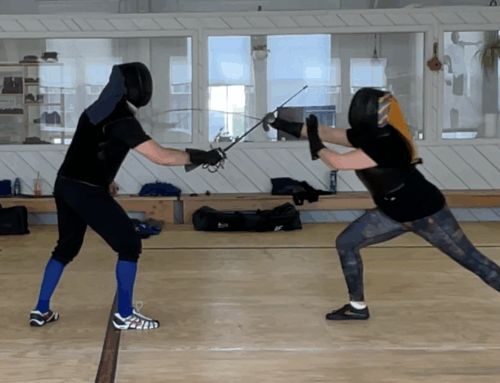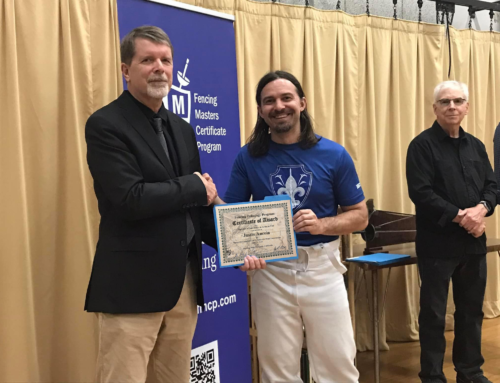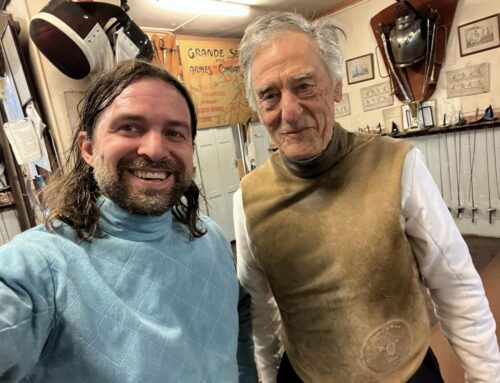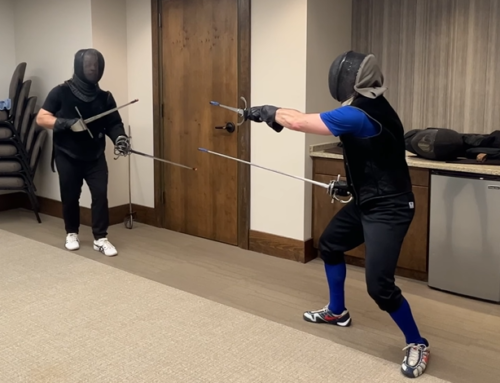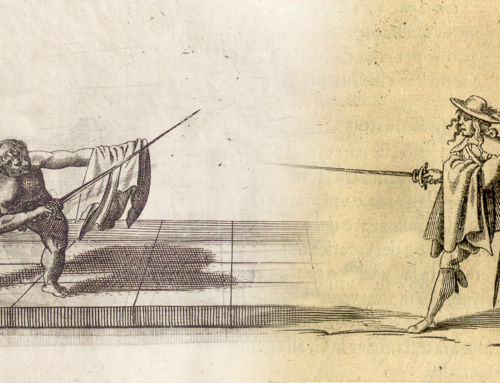This month is “Guards” month for by Back to Basics of Italian Rapier class. We’re spending the entire month looking at each of the four primary guards of Italian rapier.
Last night we focused on the first guard — Prima — including how to hold the sword & body in prima, the properties of the guard, it’s uses, and some basic plays folks can do as a solo drill.
The Basics

To start, Prima (or “first”) is called thus because it’s the natural position of the sword after drawing it from a sheath.
Fabris describes two versions. The first is when the sword just finished being unsheathed and with the arm and sword withdrawn (the bad version) and another with the arm is extended (the good or “properly formed” version).
There also seems to be two versions in Alfieri’s treatise too — the plate seems to show the bad version with the arm withdrawn while the text describes the properly formed version. Regardless, we’re going to focus on the good version of prima.
Properties

Prima is good for protecting the head on the high outside line and angling downward thrusts which can be difficult to parry. It is more easily countered with a high terza dominating the debole which is in a very weak position while in prima.
The advantages of prima is that it’s good at receiving cuts since the true edge is facing upward. Also, because we form this guard with a slight forward hinge at the pelvis, our torso is a pretty withdrawn target area; our head is a closer target for our opponent, however, it is well protected behind our hilt.
The biggest disadvantage of prima is that it can be pretty taxing on the arm and shoulders, so holding the guard long-term isn’t very feasible.
The guard also is exposed to the lower torso and legs, since the guard and forte are too far to protect them.
How to Form Prima


Feet/Stance. Hold your feet in a moderate distance (not as wide as your normal Defensive Stance).
If this is uncomfortable, you can bring them closer together (as shown in Fabris). What will work best for you will vary based on your body structure (hips, femur, etc.) and current strength/mobility level.
Roughly 80% of your weight should be held over your back leg.
Arm & Hand. Your arm should be extended at shoulder height with the hand at head level. Your hand should be turned so your palm faces the outside line and your knuckles face the sky.
Body. Hold this guard while in the Forward Guard/Offensive Posture. That means hip hinging forward over your forward-facing pelvis.
This hinging doesn’t have to be as extreme as shown in Fabris. A slight or moderate hinge is also fine if that’s more comfortable and you can move just fine.
Also engage your back muscles with a slight retraction of your scapula (shoulder blade). This will help keep your shoulders more neutral which will:
- Shift some of the sword weight off your delts and onto your back, making holding the guard longer a little easier and,
- Lessen the chance of a shoulder injury.
You may need to square up your torso a bit in this guard. That’s fine, though I would recommend not squaring up anymore than necessary.
Sword. Your sword should be held with the true edge facing up and the quillons held vertical.
The blade should be relatively straight and parallel to the ground. Prima naturally wants to angle downward and a slight dipping of the tip is ok. Aim your tip at your opponent’s eye.
You can hold your rapier in the normal grip or you can shift your thumb so it rests underneath false-edge quillon. That can sometimes help with any awkwardness of the guard.
Head. Your head should be tucked safely behind your hilt.
Off-Hand. Your off-hand should be held by your face or held by your sword-elbow to help cover the low-outside line (a closed-guard).
Plays

We also went over a few basic plays or uses for prima. This is just a sampling and not at all exhaustive.
Play #1 — From Attachment or contendere di spada
Attachment or contendere di spada is when neither you nor your opponent have a mechanical advantage over the other and are, instead, pushing laterally against one another. This common in the SCA & HEMA rapier and it’s also bad form.
- On the outside line, you and your opponent both seek to find the other’s sword. Instead, however, your blade make contact, forcefully pushing against one another.
- From here, turn your hand into prima and strike over their weapon with a cross-line step/lunge or a passing lunge.
By turning your hand into prima, you’re yielding to the opponent’s lateral pressure while also placing their debole on your forte/hilt. You gain an extremely strong leverage advantage.
This is (more or less) Plate 25 from Fabris, which I went over a little bit in a previous video.
Play #2 — Additional Leverage While Riposting
The late-Renaissance Italians weren’t fans of dui tempi/parry-riposte actions, but they’re still good to know and practice. This play shows how prima can help with
- Your opponent finds your sword on the outside line
- They attack with a lunge in seconda but attack out-of-tempo
- As they attack, you take a small retreating step and parry in terza-seconda.
- Riposte in prima.
Often parry-ripostes happen on the same line and in the same guard as the original attack, making it a pretty predictable action for the attacker to try to counter. One way of getting around this is a cavazione to the opposite line. OR, you could, after the parry, turn your hand in prima to gain the strong leverage advantage before striking.
Play #3 — Controtempo Low-Line Void
Now we’re going to move on to two low line voids uses of prima.
- You find your opponent on the inside line
- Your opponent performs a cavazione to the outside line to seek an attack in seconda
- In tempo, you turn your hand into prima and strike your opponent with either a sbasso (very low cross-line lunge) or a passata sotto (very low passing lunge/step) in controtempo.
This is (more or less) the play described in Fabris Plate 35.

Play #4 — Yielding to the Inside Line
Our last example of how to use prima also is a low-line void.
- You seek to find your opponent’s sword on the inside line. Your opponent does the same, so instead, however your blades make contact, forcefully pushing against one another. (This is just like the beginning of our first play but on the opposite line!)
- Yield to the lateral pressure of your opponent’s weapon by turning your hand into prima. Their sword should fall closer to your outside and their tip slide to your forte/hilt.
- Strike with a pasatta sotto, using your off-hand to cover your sword-side face and head.
There are more uses and plays for prima but that’s a good starting point.
Class Video
Here’s a recording of the class. It’s more or less what’s written out in this blog post, plus a strength/conditioning routine in the second half of the class.
DONATIONS: Classes are 100% free, however, if you find these sessions useful, please consider a small donation so I can continue to produce rapier & other historical martial arts content. Donate at https://www.paypal.me/thetavernknight
SOURCES
Alfieri, Francesco Ferdinando. La Scherma: The Art of Fencing. Padua, 1640. Translated and edited by Caroline Stewart, Phil Marshall, and Piermarco Terminiello. Fox Spirit Books, 2017. https://amzn.to/366AtNG
Alfieri, Francesco Ferdinando. La Scherma: on Fencing, 1640 Rapier Treatise. Padua, 1640. Translated and edited by Tom Leoni. Self-published: Lulu, 2018.
Fabris, Salvator. Scienza d’Arme (The Art of the Italian Rapier). Copenhagen, 1606. Translated and edited by Tom Leoni. Highland Village, TX: Chivalry Bookshelf, 2005.
Fabris, Salvator. Fabris’s Sienza e Pratica d’Arme, 1606. Scanned by Petteri Kihlberg (2015). Courtesy of Guy Windsor. https://gumroad.com/guywindsor#xgWFH
Vienna Anonymous on Fencing: A Rapier Masterclass from the 17th Century. Based on Fabris & Capoferro. Transcribed, translated, annotated, and edited by Tom Leoni. Self-published: Lulu, 2019.



